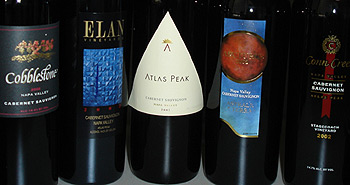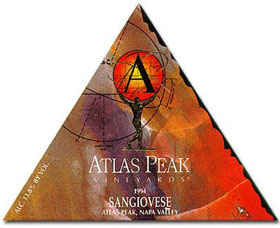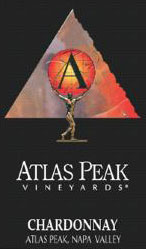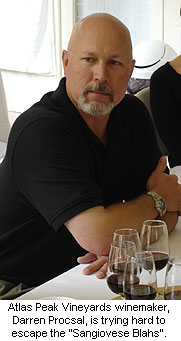

Atlas Peak winemakers look to the future with eyes
focused on Cabernet Sauvignon.
Atlas Peak ~ Napa Valley (AVA)
Atlas Peak producers try to shake the Sangiovese Blahs
Atlas Peak producers, saddled with a reputation for ‘less-than-stellar’ Sangiovese, are reinventing themselves, their vineyards, and their wines – and Cabernet is at the heart of the make-over.
by
Alan Goldfarb
May 30, 2006
When discussing the Atlas Peak American Viticulture Area (AVA) in the southeastern hills of the Napa Valley, any talk of it has to begin with Sangiovese. However, the folks involved with the dozen wineries and the approximately 15 growers now in the small region, would most likely want it to end there.

That’s because at about the time the area received its official designation in 1992, Piero Antinori, the well-respected Tuscan producer, came to Atlas Peak to help start Atlas Peak Vineyards, bringing with him Sangiovese. In so doing, the Chianti vintner, who was one of the earliest progenitors of his home’s most noble grape, believed that the variety would do well on Atlas Peak; and it caused others on the mountain to plant it, as well as prompted others around California to jump on Sangiovese’s thick back.
What resulted is for the most part mediocre California Sangiovese to the point where one has to search far to find it any longer. But Atlas Peak, the pioneer of California Sangiovese, has been saddled with the reputation of still being a proponent of the less-than-stellar variety as it has thus far performed here.
 Now, the folks up on the slopes of the mountain struggle to eschew the Curse of Sangiovese by reinventing themselves, their vineyards, and their wines. Thus, they seem now to have thrown their lot in with the five red Bordeaux varieties, particularly Cabernet Sauvignon; and Chardonnay. The idea is to throw off the yolk that Sangiovese has wrapped around their necks, and to prove that great Cabernets and Chardonnays can indeed be grown and produced on Atlas Peak.
Now, the folks up on the slopes of the mountain struggle to eschew the Curse of Sangiovese by reinventing themselves, their vineyards, and their wines. Thus, they seem now to have thrown their lot in with the five red Bordeaux varieties, particularly Cabernet Sauvignon; and Chardonnay. The idea is to throw off the yolk that Sangiovese has wrapped around their necks, and to prove that great Cabernets and Chardonnays can indeed be grown and produced on Atlas Peak.
Atlas Peak Vineyards’ winemaker Darren Procsal, who wasn’t around at the time that his winery first brought Sangiovese to the Peak, is trying hard to get past the Sangiovese perception. He calls it “The Sangiovese Blahs.”
“There are other wines and when people begin to taste those wines, it will vindicate our winemaking abilities and we think we’ll begin to get there,” he told me in a recent conversation.
Atlas Peak Vineyards itself doesn’t even produce a Sangiovese any longer as it too disengages from Antinori; although it still grows about 125 acres of the variety, which is just about all that is left in the area’s almost 1,500 acres of planted land.
So, it is Cabernet – as is the case in most of the Napa Valley – that is also taking a foothold in Atlas Peak’s thin, well-drained, red-tinged volcanic soils that are planted above the fog line.
 Even the region’s own press release describes Atlas Peak as “Not for the faint of heart, this immensely challenging and unadulterated region …” and calls it “This wine country outback.”
Even the region’s own press release describes Atlas Peak as “Not for the faint of heart, this immensely challenging and unadulterated region …” and calls it “This wine country outback.”
Aside from the fact that not one of its 12 wineries has a commercial tasting room, and its two main, but disconnected roads aren’t inviting enough to attract many tourists, wine enthusiasts are beginning to learn that the Cabernets produced on Atlas Peak, are to be acknowledged.
Since the first vineyard was planted in the appellation in 1870, local growers have faced the kinds of physical and viticulture challenges that deter all but the bravest of farmers. Simply put, this is not a user-friendly grape growing region. The lofty elevated area is located in the rugged eastern hills of Napa Valley and is known for its rocky, volcanic soil; rattlesnakes; massive boulder outcroppings; and, truly remote mountain terrain – all of which equates to inordinate amounts of time, patience and investment.
Much of the wines, by its dozen producers Astrale e Terra, Atlas Peak, Bialla, Cobblestone, Dominari, Elan, Hill Family, Jocelyn, Pahlmeyer, Rivera Vineyards, Stagecoach Vineyard, and Vin Roc, all of which make wines under 17 different labels, are just now coming to market.
And Atlas Peak’s fruit is sold to some of the most prestigious wineries in Napa Valley, including Cafaro, Cain, Caymus, Cardinale, Conn Creek, Darioush, Lokoya, Silver Oak, Stags’ Leap Winery, Stag’s Leap Wine Cellars, and ZD.
The peak itself is located on the western slopes of the Vaca Range, separating the Napa and Sacramento valleys. At an elevation of 2,663 feet, Atlas Peak is the most prominent peak in the area and became the recognized name for the surrounding region in or around 1875, when A.V. Evans built and named his legendary hotel, the Atlas Peak Resort.
Vineyards were first planted in the region in 1870, when James Reed Harris planted 1,000 vines on his ranch property located one mile southeast of the peak and now owned by Elan Vineyards. By 1893, he had grown his original one-acre planting to 47 acres of wine grapes.
From 1880 to 1901, the area experienced a slow but steady growth in vineyard acreage which surprised many – this was the first era

That’s because at about the time the area received its official designation in 1992, Piero Antinori, the well-respected Tuscan producer, came to Atlas Peak to help start Atlas Peak Vineyards, bringing with him Sangiovese. In so doing, the Chianti vintner, who was one of the earliest progenitors of his home’s most noble grape, believed that the variety would do well on Atlas Peak; and it caused others on the mountain to plant it, as well as prompted others around California to jump on Sangiovese’s thick back.
What resulted is for the most part mediocre California Sangiovese to the point where one has to search far to find it any longer. But Atlas Peak, the pioneer of California Sangiovese, has been saddled with the reputation of still being a proponent of the less-than-stellar variety as it has thus far performed here.
 Now, the folks up on the slopes of the mountain struggle to eschew the Curse of Sangiovese by reinventing themselves, their vineyards, and their wines. Thus, they seem now to have thrown their lot in with the five red Bordeaux varieties, particularly Cabernet Sauvignon; and Chardonnay. The idea is to throw off the yolk that Sangiovese has wrapped around their necks, and to prove that great Cabernets and Chardonnays can indeed be grown and produced on Atlas Peak.
Now, the folks up on the slopes of the mountain struggle to eschew the Curse of Sangiovese by reinventing themselves, their vineyards, and their wines. Thus, they seem now to have thrown their lot in with the five red Bordeaux varieties, particularly Cabernet Sauvignon; and Chardonnay. The idea is to throw off the yolk that Sangiovese has wrapped around their necks, and to prove that great Cabernets and Chardonnays can indeed be grown and produced on Atlas Peak.
Atlas Peak Vineyards’ winemaker Darren Procsal, who wasn’t around at the time that his winery first brought Sangiovese to the Peak, is trying hard to get past the Sangiovese perception. He calls it “The Sangiovese Blahs.”
“There are other wines and when people begin to taste those wines, it will vindicate our winemaking abilities and we think we’ll begin to get there,” he told me in a recent conversation.
Atlas Peak Vineyards itself doesn’t even produce a Sangiovese any longer as it too disengages from Antinori; although it still grows about 125 acres of the variety, which is just about all that is left in the area’s almost 1,500 acres of planted land.
So, it is Cabernet – as is the case in most of the Napa Valley – that is also taking a foothold in Atlas Peak’s thin, well-drained, red-tinged volcanic soils that are planted above the fog line.
-
“The more boulders we cleared with the D-8 tractor, the more they
seemed to appear. It was like a modern day myth of Sisyphus.”
 Even the region’s own press release describes Atlas Peak as “Not for the faint of heart, this immensely challenging and unadulterated region …” and calls it “This wine country outback.”
Even the region’s own press release describes Atlas Peak as “Not for the faint of heart, this immensely challenging and unadulterated region …” and calls it “This wine country outback.”
Aside from the fact that not one of its 12 wineries has a commercial tasting room, and its two main, but disconnected roads aren’t inviting enough to attract many tourists, wine enthusiasts are beginning to learn that the Cabernets produced on Atlas Peak, are to be acknowledged.
Since the first vineyard was planted in the appellation in 1870, local growers have faced the kinds of physical and viticulture challenges that deter all but the bravest of farmers. Simply put, this is not a user-friendly grape growing region. The lofty elevated area is located in the rugged eastern hills of Napa Valley and is known for its rocky, volcanic soil; rattlesnakes; massive boulder outcroppings; and, truly remote mountain terrain – all of which equates to inordinate amounts of time, patience and investment.
Much of the wines, by its dozen producers Astrale e Terra, Atlas Peak, Bialla, Cobblestone, Dominari, Elan, Hill Family, Jocelyn, Pahlmeyer, Rivera Vineyards, Stagecoach Vineyard, and Vin Roc, all of which make wines under 17 different labels, are just now coming to market.
And Atlas Peak’s fruit is sold to some of the most prestigious wineries in Napa Valley, including Cafaro, Cain, Caymus, Cardinale, Conn Creek, Darioush, Lokoya, Silver Oak, Stags’ Leap Winery, Stag’s Leap Wine Cellars, and ZD.
The peak itself is located on the western slopes of the Vaca Range, separating the Napa and Sacramento valleys. At an elevation of 2,663 feet, Atlas Peak is the most prominent peak in the area and became the recognized name for the surrounding region in or around 1875, when A.V. Evans built and named his legendary hotel, the Atlas Peak Resort.
Vineyards were first planted in the region in 1870, when James Reed Harris planted 1,000 vines on his ranch property located one mile southeast of the peak and now owned by Elan Vineyards. By 1893, he had grown his original one-acre planting to 47 acres of wine grapes.
From 1880 to 1901, the area experienced a slow but steady growth in vineyard acreage which surprised many – this was the first era














